Related Research Articles

Eldersburg is an unincorporated community and census-designated place (CDP) in Carroll County, Maryland, United States. The population was 30,531 at the 2010 census.

Lake Austin, formerly Lake McDonald, is a water reservoir on the Colorado River in Austin, Texas. The reservoir was formed in 1939 by the construction of Tom Miller Dam by the Lower Colorado River Authority. Lake Austin is one of the seven Highland Lakes created by the LCRA, and is used for flood control, electrical power generation, and recreation.

The Patapsco River mainstem is a 39-mile (63 km) river in central Maryland that flows into the Chesapeake Bay. The river's tidal portion forms the harbor for the city of Baltimore. With its South Branch, the Patapsco forms the northern border of Howard County, Maryland. The name "Patapsco" is derived from the Algonquian pota-psk-ut, which translates to "backwater" or "tide covered with froth."
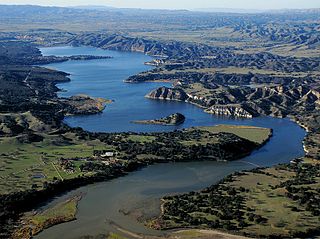
Cachuma Lake is a reservoir in the Santa Ynez Valley of central Santa Barbara County, California on the Santa Ynez River adjoining the north side of California State Route 154. The artificial lake was created by the construction of Bradbury Dam, a 201 ft (61 m) earth-fill structure built by the U.S. Bureau of Reclamation in 1953. Its surface area covers 3,100 acres (1,300 ha), with a maximum design capacity of 205,000 acre⋅ft (253,000,000 m3), but it is currently limited to 188,000 acre⋅ft (232,000,000 m3) due to sediment accumulation. The late-December 2022 and early-January 2023 storms dramatically raised the water level in the lake, from an average of 33% full to 100% full for the first time in 12 years.

Deep Creek Lake State Park is a public recreation area occupying more than 1,100 acres (450 ha) on the northeast side of Deep Creek Lake in Garrett County, Maryland, in the United States. The park features water activities, camping facilities, and recreational trails and is located about 18 miles (29 km) south of Interstate 68 on U.S. Route 219.
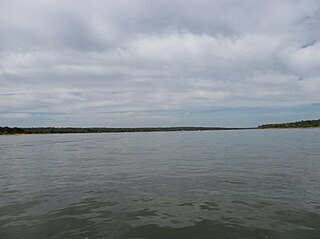
Lake Thunderbird is a reservoir located in Norman, Oklahoma. The lake was constructed between 1962 and 1965 for the purpose of providing municipal water to the nearby communities of Del City, Midwest City and Norman. It is formed by an earthfill embankment (dam) 7,300 feet (2,200 m) long and up to 144 feet (44 m) high on the Little River. In addition to being a source for drinking water, Lake Thunderbird's secondary uses include numerous recreational activities.

Skiatook Lake is a federally-owned and operated reservoir located in Osage County, Oklahoma, 4 miles (6.4 km) west of the town of Skiatook, 11 miles (18 km) east of Hominy, Oklahoma and about 18 miles (29 km) from Tulsa. The Skiatook Dam is located on Hominy Creek, 14 miles (23 km) upstream of the confluence of Hominy and Bird Creeks. The project purposes include flood control, water quality, water supply, recreation, and fish and wildlife management. The cities of Skiatook, Sand Springs, Sapulpa, and Tulsa use Skiatook Lake as a municipal water supply. Gentle rolling hills of Blackjack and Post Oak interspersed with Tallgrass prairie surround the lake. The lake is under the management of the U.S. Army Corps of Engineers, Tulsa District.

DeGray Lake is a reservoir on the Caddo River constructed by the United States Army Corps of Engineers in Arkansas, 8 miles (13 km) from Arkadelphia. Arkansas Scenic Byway 7 is located on the eastern shore of the lake, and provides views of the lake, and also places to stay. DeGray Lake Resort State Park was opened in 1974 to encourage tourism and recreation on DeGray Lake.

Choke Canyon Reservoir is a reservoir in South Texas, United States. The lake and the dam that creates it are owned by the United States Bureau of Reclamation and managed by the City of Corpus Christi.
Lake Gonzales is a reservoir on the Guadalupe River 4 miles (6 km) southeast of the town of Belmont in Gonzales County, Texas. The reservoir was formed in 1931 by the construction of a dam to provide hydroelectric power to the area. Management of the dam and lake was assumed by the Guadalupe-Blanco River Authority on May 1, 1963.
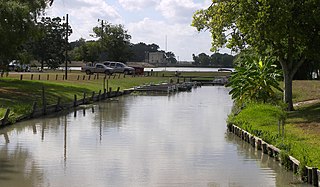
Lake Wood was a reservoir on the Guadalupe River 4 miles (6 km) west of the town of Gonzales in Gonzales County, Texas. The reservoir was formed in 1931 by the construction of a dam to provide hydroelectric power to the area. Management of the dam and lake was assumed by the Guadalupe-Blanco River Authority on May 1, 1963. Lake Wood served as a venue for outdoor recreation, including fishing and boating.
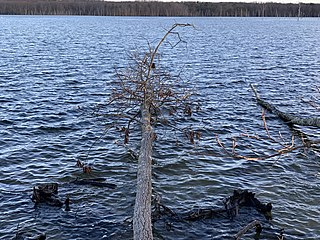
The Manasquan Reservoir is a source of water for municipalities and utilities, as well as a 1,204-acre (4.87 km2) park, located in Howell Township, in Monmouth County, New Jersey, United States. The reservoir doubles as a park that is part of the Monmouth County Park System. The park has trails, a visitor's center, a nature/environmental center, a boat launching area and several dikes for fishing, among its facilities. The reservoir itself, which is dammed from the Manasquan River, is operated by the New Jersey Water Supply Authority, which is a part of the much larger Raritan Basin Watershed. The nature trails circling around the reservoir are what makes this county park as one of the most popular hiking destinations in Central New Jersey, as the park receives over one million visitors a year. It is reachable by car and there are five parking lots, including one for vehicles hauling trailers. The park's trails are open to walkers, runners, hikers, bicyclists and equestrians.
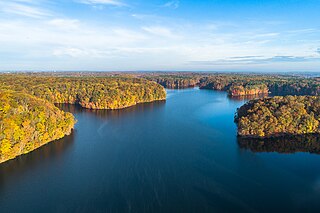
Liberty Reservoir is a reservoir west of Baltimore, Maryland; about a mile north of Patapsco Valley State Park's McKeldin area. It is owned by the City of Baltimore Department of Public Works, but is located outside the city, and it divides Baltimore and Carroll Counties.

Englebright Lake is an 815 acre reservoir on the Yuba River, impounded by Englebright Dam, in the Sierra Nevada, Northern California, United States. The reservoir stores 45,000 acre feet of water with nearly 24 miles of shoreline.

Bear Branch Nature Center is a nature center in Carroll County, Maryland near Westminster. It features interpretive exhibits about local plants and animals, an outdoor water feature and play area, a Discovery Room for children, an observation beehive, live animals including an eagle, hawks, owls, snakes, salamanders, turtles, frogs, and toads, a planetarium and observatory. The center is a facility of Carroll County Recreation & Parks.

Coyote Lake is an artificial lake in Santa Clara County, California, United States, between Morgan Hill and Gilroy.

New Germany State Park is a public recreation area covering 483 acres (195 ha) adjacent to Savage River State Forest in Garrett County, Maryland. The state park is administered by the Maryland Department of Natural Resources.

Centennial Lake is a man-made 54-acre (220,000 m2) reservoir, in a 325-acre (1.32 km2) park in Howard County, Maryland, near Columbia, Maryland and Clarksville, known as Centennial Park. It was created by damming the Centennial Branch of the Little Patuxent River. The lake and the park feature a dam, a wildlife area, a walking trail, boating, fishing, and other recreational activities. The park is owned by the Howard County Department of Recreation and Parks.

Cayuga Inlet is a river located in Tompkins County, New York. It flows into the south end of Cayuga Lake by Ithaca, New York.
Lake Athens is a 1,799 acre reservoir located to the east of Athens, Texas in Henderson County.
References
- ↑ "Piney Run Park". Maryland Department of Natural Resources. Archived from the original on 2011-08-24. Retrieved 2011-08-16.
- ↑ "39-Inch Bass Wins Piney Ridge Big Fish Contest". Eldersburg, MD Patch. 2017-11-30. Retrieved 2019-04-03.
- ↑ Hare, Mary Gail. "Fast-growing hydrilla could affect water supply at Piney Run Lake". baltimoresun.com. Retrieved 2019-04-03.
- ↑ White, Jack (January 20, 2015). "The Great War-Robin Frazier versus Piney Run Lake". www.sykesvilleonline.com. Retrieved 2019-04-03.
- ↑ Maryland Department of the Environment; Water Protection Division U.S. Environmental Protection Agency (2003). "Water Quality Analysis of Sedimentation for Piney Run Reservoir in Carroll County, Maryland" (PDF). Maryland Department of the Environment.
{{cite web}}: CS1 maint: multiple names: authors list (link) - ↑ "Piney Run Park - 2 Tennis Courts in Sykesville Maryland". www.globaltennisnetwork.com. Retrieved 2019-04-03.
- ↑ The Baltimore Sun. "Carroll County Parks". baltimoresun.com. Retrieved 2019-04-03.
- ↑ Carroll County Department of Recreation and Parks (2018). "2018 Piney Run Park Brochure" (PDF).
- ↑ News Desk, News Partner (2018-03-22). "Great Blue Heron To Be Unveiled At Piney Run Park". Eldersburg, MD Patch. Retrieved 2019-04-03.
- ↑ "Piney Run Park Nature Center". Carroll County Department of Recreation and Parks.
- ↑ NatureFind. "Piney Run Nature Center and Park" . Retrieved 2019-04-03.
- ↑ Rose, Autumn (March 6, 2012). "Registration for County park summer camps now open". Carroll County Times. Retrieved 2019-04-03.
- ↑ "Piney Run Apple Festival | Visit Maryland". www.visitmaryland.org. Retrieved 2019-04-03.
- ↑ May, Bill (2013). "Carroll Outdoors: Kayaking at Piney Run Park". Carroll County Times. Retrieved 2019-04-03.
- ↑ Carroll Magazine (February 14, 2013). "Stressed and Out of Shape? Take a Yoga, Tai Chi or Karate Class". Carroll Magazine. Retrieved 2019-04-03.
- ↑ Commissioner of Carroll County (2019). "Piney Run Park Fishing Structure Map" (PDF). Carroll County Department of Recreation and Parks.
- ↑ Maryland Department of the Environment; Water Protection Division U.S. Environmental Protection Agency (2003). "Water Quality Analysis of Sedimentation for Piney Run Reservoir in Carroll County, Maryland" (PDF). Maryland Department of the Environment.
{{cite web}}: CS1 maint: multiple names: authors list (link) - ↑ Commissioner of Carroll County. "Fishing and Boating Regulations at Piney Run Park" (PDF). Carroll County Department of Recreation and Parks.
- ↑ Young, Debra Taylor (2001). "Piney Run lures anglers with night fishing". The Baltimore Sun. Retrieved 2019-04-03.
- ↑ "Freshwater Fishing at Piney Run Reservoir". Rudow's FishTalk Magazine. Retrieved 2019-04-03.
- ↑ Hare, Mary Gail. "Fast-growing hydrilla could affect water supply at Piney Run Lake". The Baltimore Sun. Retrieved 2019-04-03.